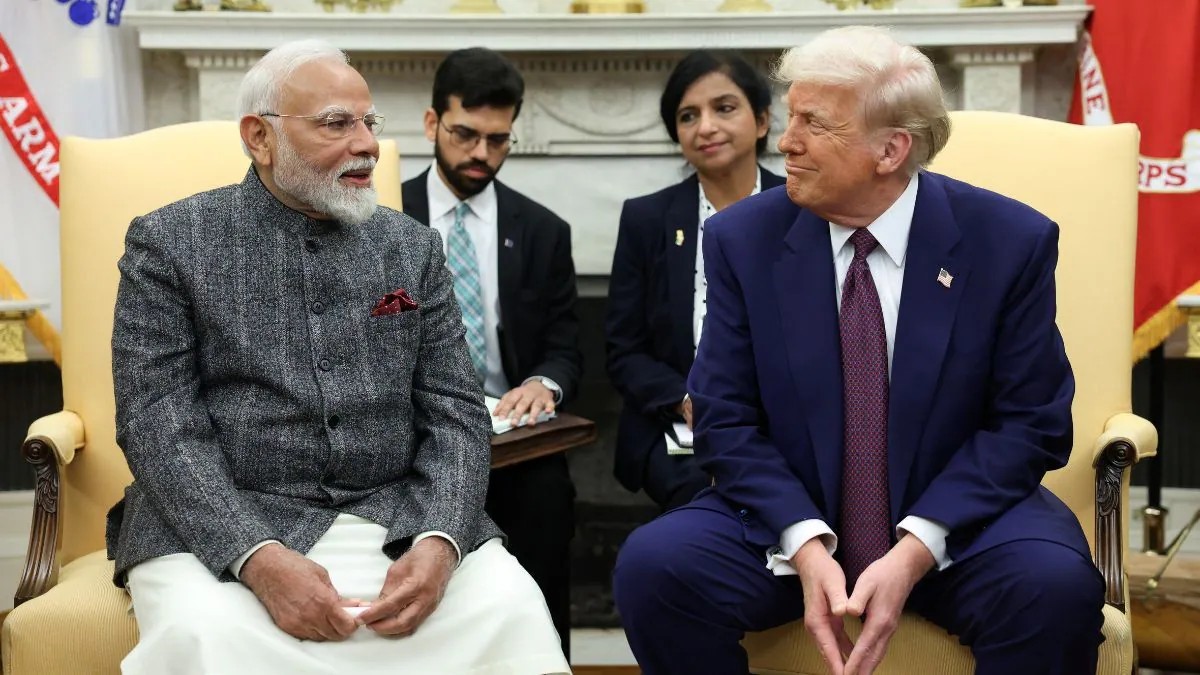Trump’s Tariffs: A Catalyst for India’s Reforms
Syllabus:
GS-2:
Bilateral Groupings & Agreements , Effect of Policies & Politics of Countries on India’s Interests , Indian Diaspora , Groupings & Agreements Involving India and/or Affecting India’s Interests
Focus:
Trump’s recent tariff policies, focusing on China, have opened a unique opportunity for India to address its economic stagnation by initiating much-needed reforms in trade, foreign investment policies, and industrial regulations. This moment mirrors India’s economic crossroads similar to the 1991 reforms.
Trump Tariffs and Global Shifts:
The New Economic Order Post-Trump Tariffs
- Trump Tariffs (TT) Introduced on April 2, 2025: The announcement of reciprocal tariffs brought uncertainty in the global economy, but they appear to be more about politics than economic logic.
- Political Economy Behind the Tariffs: The true intention of the tariffs is believed to be linked to China’s ambition to challenge the US’s economic hegemony.
- China’s Long-Term Strategy: According to Rush Doshi, China aims to displace the US as the world’s dominant economic power. This long-term goal shapes China’s mercantilist economic policies, which prioritize exports, limit imports, and accumulate reserves.
China’s Economic Growth: The Mercantilist Path
- China’s Mercantilist Approach: Since the 1960s, China’s focus on maximizing exports and maintaining low imports has helped it become the world’s leading manufacturing power.
- Impressive Growth Record: By 2010, China’s consumption-to-GDP ratio was 35%, reflecting its effective mercantilist policies. In comparison, the US, post-World War II, had a dominant share of global manufacturing exports. However, China has now achieved a manufacturing goods export share of 30%.
- US Response to China’s Rise: The US response to China’s growing influence has been bipartisan support for aggressive trade actions, which continued under President Biden, despite initial expectations that he would abandon Trump’s policies.
India’s Economic Inertia: Why Reforms Have Been Stalled
India’s Economic Comfort Zone
- Slow Growth but Steady Progress: Over the past 33 years, India has grown at a steady rate of 6.2% annually. This steady growth has led to complacency, with policymakers preferring the status quo over bold reforms.
- The “Don’t Rock the Boat” Mantra: The prevailing sentiment among India’s politicians and elites has been to avoid taking risks that could disrupt the comfortable economic structure.
- FDI Decline Despite Growth Potential: India’s Foreign Direct Investment (FDI) has seen a significant decline in recent years, falling from 2-2.5% of GDP to below 1%, resembling the levels seen in the late 1990s. The decline is attributed to an environment of comfort and reluctance to reform.
FDI Policies and Investor Discomfort
- Government’s “Model” Bilateral Investment Treaty (BIT) in 2015: India introduced a treaty requiring foreign investors to settle disputes in Indian courts. The assumption was that there would be enough demand for investment to compel foreign companies to accept Indian arbitration.
- Discomfort Among Foreign Investors: In practice, foreign investors prefer international courts over Indian courts for arbitration. This has led to a significant exit of foreign investors, as India’s business environment failed to meet their expectations.
The Challenge of Reform: Domestic Resistance and Political Economy
Political Economy and Resistance to Reform
- Political Divisions Hindering Reform: India’s political opposition is fragmented, making it harder to advocate for substantial economic reforms. Moreover, many Indian industrialists resist reforms because they could lead to increased competition, which may reduce their existing profits.
- Lack of Political Will for Reforms: The country’s political economy, dominated by deep-seated interests, resists changes that could disrupt the comfort zone of existing stakeholders.
- Historical Anti-Reform Movements: The opposition to the 2020-21 farm laws is a prime example of how reforms are often derailed due to fear of competition or losing political support.
The Role of India’s Political Economy
- The Deep State and Economic Comfort: Many oligarchs within the “Deep State” benefit from existing policies, which further complicates efforts for economic liberalization.
- Industrialists’ Resistance to Change: Large industrialists, accustomed to easy profits, are often averse to reforms, as they might face challenges from new, more competitive players entering the market.
The Trump-Driven Catalyst: Exogenous Shock for Reform
The External Push for Reform
- Trump’s Demands for Industrial and Agricultural Reforms: The Trump administration’s tariffs, though disruptive, provide India with a unique opportunity to reform its economy. These external shocks can push India to make much-needed industrial and agricultural reforms, which would have been difficult to implement otherwise.
- Reduced Risk for Reforms: The global context created by Trump’s policies provides the government with a “helplessness” excuse to push through economic reforms, which might have faced greater resistance in a more stable environment.
- Political Economy Forces at Play: The external pressures force India to move out of its comfort zone, presenting a rare opportunity to introduce reforms without the usual political backlash.
The Role of the West in Supporting India’s Economic Rise
- India as a Counterweight to China: The West now views India as a necessary counterbalance to China’s growing influence. The US and other Western nations need India to ensure a multipolar global order.
- India’s Demographic Dividend: South Asia, especially India, has a growing labor force that can serve as a major asset in the coming decades. India’s young, educated, and capable workforce has the potential to match China in terms of economic power.
The Road Ahead: Economic Reform and India’s Future Growth
India’s Potential for Rapid Growth
- Bright Economic Prospects: India’s educated workforce, combined with its demographic dividend, makes it a formidable competitor to China. In a few years, India’s prime-age labor force could exceed China’s.
- The Choice Between Comfort and Growth: India faces a clear choice: continue growing at a steady 6.2% or accelerate its GDP growth to 7.5-8.5% by embracing trade liberalization, opening up for more FDI, and pursuing deep deregulation.
The Second 1991 Moment: A New Economic Opportunity
- Historical Parallel with 1991: The present moment is being compared to India’s 1991 economic crisis, which forced India to adopt market reforms. The global environment and internal pressures could create a similar opportunity for India to implement significant economic changes.
- Negotiations for a Bilateral Trade Agreement (BTA): India is in the process of negotiating a BTA with the US, which could set the tone for similar agreements with other major economies like the UK and EU.
- The Likely Reform Path Ahead: As India prepares for a reformed industrial order, it seems increasingly likely that the government will seize this moment to implement structural changes, marking a new phase of economic growth.
Conclusion: Embracing Reform for a Bright Future
India stands at a crossroads, with the opportunity to reform its trade and investment policies, driven by both internal and external pressures. While comfort has delayed these reforms in the past, the current global dynamics and the rise of China provide a unique moment for India to embrace change. The second 1991 moment is within reach, and with it, the potential for rapid economic growth and a more competitive global position.
Source: TH
Mains Practice Question:
In light of global trade shifts, critically analyze how India can utilize external pressures, such as Trump’s tariff policies, to undertake domestic economic reforms. Discuss the potential benefits and risks of such a strategy for India’s long-term growth.




